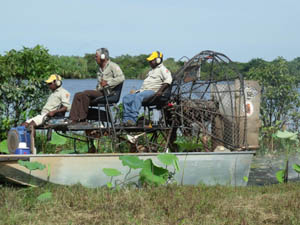Indigenous communities managing biosecurity risks
 Indigenous communities of Northern Australia have a long-standing connection in plant biosecurity issues through culture and tradition to the land and sea.
Indigenous communities of Northern Australia have a long-standing connection in plant biosecurity issues through culture and tradition to the land and sea.
As part of our research project ‘An Indigenous community and local knowledge-based model to manage harmful plant pests and diseases, CRC70138’ in Northern Australia and Eastern Indonesia, we are committed to biosecurity management with Aboriginal people, as well as the relevant government agencies. This is achieved through supporting enterprise development, meaning Aboriginal people can remain on country and in homelands.
Biosecurity management through enterprise (contracts with groups like Caring for Country, Australian Quarantine and Inspection Service and other resource based industries) enables a source of employment for Aboriginal people which provides economic, cultural, social and environmental sustainability.
Our research has identified three key features of partnerships that support the community based management of plant biosecurity. Firstly, there is a need to understand the way local communities interact with policy and industry. Secondly, the potential of enterprise development in engaging local communities in the long term is discussed. Finally, the research has developed a training framework to endorse cultural and Western knowledge about plant biosecurity for the community management of biosecurity.
There is a significant opportunity to proactively work with local communities both in northern Australia and south-east Asia to develop and implement novel threat mitigation strategies that bridge diverse knowledge systems and their underlying perspectives.
The successful identification, management and eradication of plant biosecurity incursions across the extensive and sparsely populated Northern Australian coastline is a significant challenge. Plant incursions include weeds such Mimosa (Mimosa pigra) and Parkinsonia (Parkinsonia aculeate) which threaten large areas of southern Arnhem Land. These incursions impact on Aboriginal people's lives as they compete with, and displace, wetlands’ fauna and flora.
The flora and fauna are important food sources. Without access to these sources people consume poorer quality commercial food products, which impacts community members’ health outcomes. In addition, weed eradication work undertaken by Aboriginal people has implications for the Australian agriculture industry that would otherwise need to expend considerably more than the current $4 million per year to address production losses and manage costs (Altman, Kerins, Fogarty and Webb, 2008).
Effective partnerships between Indigenous land managers and relevant government agencies have developed to undertake biosecurity management in these remote regions. This biosecurity surveillance, reporting and management work has the potential to be developed to support economic, cultural and social sustainability in remote Indigenous communities. This has been recognised by the Commonwealth governments unit natural resource management initiatives established through the Caring the Country program. This program integrates delivery of the Australian government's previous natural resource management programs, including the Natural Heritage Trust, the National Landcare Program, the Environmental Stewardship Program and the Working on Country Indigenous land and sea ranger program. The potential for stabilising and extending these programs and securing the environmental, agricultural industries’ and Indigenous people's futures is being realised through connection to emerging enterprises and existing areas of expertise.
Embedding plant biosecurity at a local and national level draws together the principles of community management of plant biosecurity in relation to leadership, governance and change. This proactive approach to managing harmful plant pests and diseases, works through social partnerships in learning across community, policy, regional and national boundaries. These partnerships connect biosecurity management and implementation with existing economic, cultural and social structures and so increase chances of sustainability. In Australia, this strategy has been developed to respond to the changing nature of work and economic viability of Indigenous people in remote and regional communities. This is responsive to recent national policy changes in relation to Indigenous community and workforce development and Indigenous people’s desire for economic independence.
Leading the CRC’s research component of community engagement with Indigenous communities, Charles Darwin’s University’s, Ruth Wallace recently coordinated a visit in conjunction with Lhaynupuy Homelands Association and Northern Territory Parks and Wildlife.
Both Laynhapuy and Northern Territory Parks and Wildlife are keen for people to learn from others and to see the environmental threats for their community and culture. Charles Darwin University is undertaking strengths based learning activities as part of the Conservation and Land Management Training Package that encourage connection to country and others’ experiences and meet the industry standard. This training also helping people manage their country so they don’t lose culture.
During the trip, the team recorded the range of skills developed and demonstrated by Indigenous rangers in order to make teaching resources in Yolngu Mathu and English. These will be used to make information resources to teach young Aboriginal people and other rangers about the role of rangers, identifying plant incursions and the value of being a ranger as a long term career. These will be used with a range of training and knowledge management resources being developed by ranger groups across Northern Australia made with Aboriginal people for Aboriginal people.
ABC’s Stateline recently aired footage of the visit, highlighting to the audience the important roles the rangers and Indigenous communities play in helping to keep Australia free from harmful plant pests and diseases. You can view the program online.
Photo caption: Rangers from Laynhapuy Yirralka Homelands Association Inc and NT Parks and Wildlife survey the extent of weed invasion

